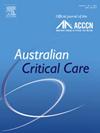Do virtual reality interventions cause seizures in the critically ill? A rapid review
IF 2.7
3区 医学
Q2 CRITICAL CARE MEDICINE
引用次数: 0
Abstract
Objectives
The objective of this research was to investigate if the use of virtual reality, increasingly utilised within intensive care medicine due to its demonstrated benefits in improving pain and anxiety, has been reported to result in seizures.
Review method used
A rapid systematic review and synthesis of qualitative and quantitative data was performed.
Data sources
Five databases (PubMed, Scopus, EMBASE, PsycInfo, and CINAHL) were systematically searched. An additional gray literature search was also conducted. Articles were restricted to those published on or after January 1st, 2014.
Review methods
The number of participants, virtual reality sessions, and length of sessions was undertaken. Subgroup analysis was undertaken for both adult and paediatric patient populations. An additional subgroup analysis was undertaken on articles which did not exclude individuals with a history of epilepsy. A tailored risk-of-bias assessment was conducted.
Results
Of the 563 articles identified through database and gray literature searching, 27 articles met inclusion criteria. A total of 886 patients have been reported within the literature with a combined 1843 virtual reality sessions, totalling more than 614.64 h of virtual reality. No seizures have been reported within intensive care patients receiving virtual reality interventions.
Conclusions
Historically, individuals with a history of epilepsy and photosensitivity have been commonly excluded from interventions and clinical trials involving virtual reality. The results of this systematic review demonstrate that the risk of virtual reality is minimal when utilised appropriately. A history of photosensitivity or epilepsy should not constitute an absolute contraindication for the use of virtual reality. Instead, clinicians should utilise clinical judgement when evaluating a patient's risk and ensure that appropriate visual experiences are utilised which do not unnecessarily strobe the patient.
虚拟现实干预会导致危重患者癫痫发作吗?快速回顾
使用的综述方法对定性和定量数据进行了快速系统综述和综合。数据来源系统检索了五个数据库(PubMed、Scopus、EMBASE、PsycInfo 和 CINAHL)。另外还进行了灰色文献检索。文章仅限于 2014 年 1 月 1 日或之后发表的文章。回顾方法对参与者人数、虚拟现实疗程和疗程长度进行回顾。对成人和儿科患者进行了分组分析。另外还对未排除癫痫病史患者的文章进行了亚组分析。结果在通过数据库和灰色文献检索确定的 563 篇文章中,有 27 篇符合纳入标准。文献中总共报道了 886 名患者,共进行了 1843 次虚拟现实治疗,虚拟现实时间总计超过 614.64 小时。接受虚拟现实干预的重症监护患者中没有癫痫发作的报道。结论从历史上看,有癫痫病史和光敏性疾病的人通常被排除在涉及虚拟现实的干预和临床试验之外。本系统综述的结果表明,如果使用得当,虚拟现实技术的风险很小。光敏感或癫痫病史不应构成使用虚拟现实技术的绝对禁忌症。相反,临床医生在评估患者的风险时应利用临床判断,并确保利用适当的视觉体验,而不会对患者造成不必要的频闪。
本文章由计算机程序翻译,如有差异,请以英文原文为准。
求助全文
约1分钟内获得全文
求助全文
来源期刊

Australian Critical Care
NURSING-NURSING
CiteScore
4.90
自引率
9.10%
发文量
148
审稿时长
>12 weeks
期刊介绍:
Australian Critical Care is the official journal of the Australian College of Critical Care Nurses (ACCCN). It is a bi-monthly peer-reviewed journal, providing clinically relevant research, reviews and articles of interest to the critical care community. Australian Critical Care publishes peer-reviewed scholarly papers that report research findings, research-based reviews, discussion papers and commentaries which are of interest to an international readership of critical care practitioners, educators, administrators and researchers. Interprofessional articles are welcomed.
 求助内容:
求助内容: 应助结果提醒方式:
应助结果提醒方式:


